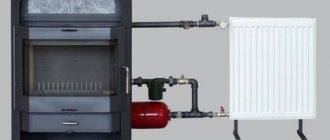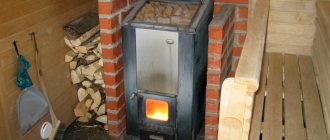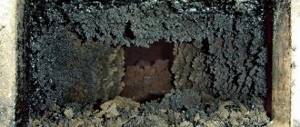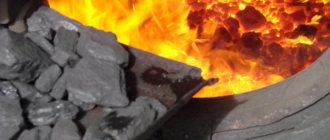Today we will consider a question that has been of great concern to me for the last three months - how to make heating in a bathhouse.
The question arises: why is heating required in the bathhouse, since it heats itself? Heating in a bathhouse is needed in order to provide the most basic amenities together with bathing procedures, namely:
- Warm toilet with a water closet and the possibility of draining into a common house sewer or a separate sewer.
- Water supply in winter, possibility of installing a boiler for preparing hot water supply and shower.
- Heating the bathhouse to maintain positive temperatures between the fireboxes, to save firewood for heating the bathhouse.
Of course, you will need all this if your bathhouse is located next to your permanent residence, and not in a country house 200 km from the city. Because, even if you want to provide the “country” version of the bathhouse with heat, there are many force majeure circumstances that may prevent you from doing this.
But first, let's figure out how you can make heating in a bathhouse, on what principle and what are the pros and cons of this.
Bath heating system: brief description, main advantages and disadvantages
Constant heating of the bath can be organized in several ways:
- Connecting to centralized heating is not the cheapest, but the easiest option.
- Liquid or solid fuel boiler. The disadvantages are the same as those of a sauna stove: constant addition of fuel is required.
- Using electricity is quite simple if it is possible to provide a separate, and what is important - guaranteed, 220/380V input (depending on the power of the heating boiler). But, firstly, you will need a whole package of documentation, which means money and time, and secondly, in rural areas there are often blackouts, and if your bathhouse is located in a summer cottage, then blackouts may be the rule and not the exception. A power outage for several days in winter can cause the system to freeze. Heating using electricity also includes electric heated floors. The pleasure is not cheap, but comfortable. And you don’t have to cook batteries or registers; power outages do not have such fatal consequences: there is no water and nothing can go bad.
The heating arrangement in the bathhouse may look like this
- Gas boiler or convector. If your site has such a luxury as natural gas, then why not use it to heat your bathhouse? Of course, you need permits and a design, and gas boilers are not cheap, but the result is worth it.
- Use a pellet boiler. These systems are becoming increasingly popular. Firstly, due to the automated heating process. Pellets (from one bucket to several tons) are loaded into the bunker, and from there they are automatically fed into the boiler. You can check such a heating system once a month, or even less often: the fuel has a low ash content, and the bunker for storing it can be very large. Secondly, the installation of such a boiler does not require approvals, although the presence of electricity for ignition is required. But not everything is so rosy - pellet boilers have a high price.
- If there is a heated house on the site, an option is to extend the heating main from the house to the bathhouse and heat it that way.
Heating in the bathhouse. We all want warmth
Bath heating with gas boilers
If gas is supplied to the site, then, naturally, gas heating of the bathhouse is the best option and installing a gas boiler will pay off: they work flawlessly, heat rooms that are quite large in size, and gas does not cost much in our country. There is no soot, soot, or heavy odor. You can do it yourself to heat a sauna using gas, but you must have a project and carefully monitor its implementation. In general, gas heating is an economical and profitable option for the owner, but gas lines in a country house or village are the exception to the rule rather than the rule, so you have to think about how to heat a bathhouse without gas.
Heating a bathhouse in winter. Which method to choose
Preparation of documents and obtaining permission
We have already mentioned that before starting construction it is worth checking the project and clarifying whether it is possible to supply gas to the bathhouse as intended by the owner. If everything is in order, construction can begin. A permit to build a bathhouse is not required. It is received only if the bathhouse is registered as a garden house.
Then documents are prepared to obtain consent for gasification:
- application for the provision of technical conditions;
- passport and title documents of the owner of the site;
- calculation of maximum consumption in one hour;
- site plan or diagram;
If the gas pipeline is private property, then the consent of the owner must be attached. After the gas distribution company issues the specifications, you need to make adjustments and invite a gas service inspector.
If the building complies, he will issue a permit for gas supply and an equipment layout diagram.
Since gas workers are much more willing to issue permits for gasification of residential buildings, many owners register the bathhouse in this very status. This simplifies obtaining technical specifications and speeds up the process
You can do the same with an old bathhouse already built on the site. It is possible that to bring it into proper condition it will only be necessary to organize additional window openings and an emergency exit.
True, practice shows that the percentage of obtaining permits in such cases is extremely low.
Electric heating
There are several options: you can install an electric boiler, since electricity is available almost everywhere. If we talk from a safety point of view, an electric boiler for heating a bathhouse is the safest option (subject to compliance with the rules and regulations). But the downside is that electricity costs a lot today, so you will have to pay large electricity bills. Another difficulty is that you will have to provide a separate input to connect the boiler, and often not 220V, but 380V is required, and these are completely different requirements and tariffs.
Electric boilers for water heating baths
If you use modern models of electric water heating units, then the bills may not be very large: they are controlled automatically, which maintains the set temperature in the room. You can set the temperature to +50C while you are not visiting the bathhouse. And the system will not freeze, and the bill will be small (provided that your building is well insulated). Moreover, to heat the bath, you can use stepped heating element boilers, induction and electrode (ion). They are not ideal, but according to experience, they are economical: bills come in 20-30% less.
Bath heating with convectors
If possible, it is most convenient to use electric convectors. Such a heating system in a bathhouse, of course, will be expensive. The equipment is not cheap, and electricity bills will also be hefty. But what is good about modern convectors: it is possible to set a certain thermal regime, which is maintained automatically. Many bathhouse owners do the following: while using the bathhouse, they heat the heater, and then set the anti-defrosting mode of the convector, which maintains the room temperature within +1 - +30C. Thus, the bathhouse premises do not freeze or become damp, and heating the bathhouse in winter will not cost a lot of money.
Heating in the bathhouse using convectors. Simple, but expensive and not always reliable
Electric heated floors
A very comfortable, but expensive type of heating. This applies to both the arrangement and the bills that will arrive. But if the bathhouse is insulated correctly and carefully, then maintaining the minimum temperature may not be so burdensome.
One more point: the system is installed at the stage of construction or major renovation, which is also not very convenient. Modern electric heated floors are no longer just cords that were laid out on the surface, and if damaged, part of the floor turned out to be unheated. There are roll materials with parallel thermal tracks. If one or more fail, the performance of the others remains unchanged, and the floor is still as warm.
Warm floors in the bathhouse can be made electric or water
Device specifics and functionality
The bathhouse is built mainly separately from the main housing, so it is equipped with its own boiler and heating circuit. If you install a double-circuit model with a boiler, hot water will always be available. The downside of the solution is that in winter you will have to make sure that no water remains in the system; every time you use the steam room, it needs to be filled and drained.
If you are planning a sauna with a stove-heater, a single-circuit boiler will be sufficient; in this case, the water for hygiene procedures will be heated separately. When arranging a sauna, you should ensure that the equipment has two circuits - for servicing the water in the pool and for heating the bath rooms. When the complex has a swimming pool, the heating system can be organized using several methods:
- autonomous heating, powered by solar panels or a heat pump;
- heat exchanger and pump combined in a heating circuit;
- pumping antifreeze into pipes;
- installation of a flow heater with a heating element.
The priority is given to electric sauna boilers, which are supplied with a complete set of piping:
- circulation pump;
- filter designed for fine cleaning;
- thermostat;
- expansion tank;
- safety valve.
An example of an electric boiler for a bath.
A useful option will be auto-shutdown elements that are triggered in an emergency: when a pressure drop or overheating occurs. The possibility of switching from summer to winter mode is welcome; in this case, energy savings are realized.
Solid fuel boilers
A special place is occupied by combined boilers using liquid or solid fuel. The option is economical, but not entirely profitable. The price of liquid fuel is constantly increasing, so installing heating in a bathhouse that works on this principle is not entirely profitable. It is more economical to use firewood or coal. But in this case, you need to understand that they will have to be delivered frequently, and the area with the bathhouse must be available at any time of the year. And still the same drawback: “autonomously” such boilers only work for a few hours. For heating baths located in suburban areas, this is not a solution.
Solid fuel boilers. Possible, but not ideal
Today, a combined bath heating system is becoming more and more common. For this purpose, multi-fuel boilers are used. In the absence of any type of fuel, it simply switches to electricity. But these boilers are only suitable for water heating, and it is difficult to install. But having set a goal, almost every person with minimal experience will be able to create a heating system in a bathhouse with their own hands and set it up uninterrupted.
We combine the heating of the dacha with the heating of the bathhouse
Twenty or thirty years ago, it never occurred to anyone that it was possible to create heating for a bathhouse from home. It was always believed: a bathhouse, there is a bathhouse, a house, there is a house, and they will not be connected together. However, modern technologies, the desire of owners to save money, and some other needs make it possible to think about how to install heating from a house to a bathhouse.
Any boiler requires a separate room, which must comply with all safety regulations and standards. In fact, without creating and approving a project in the relevant authorities, nothing will happen. All this requires both time and significant financial costs.
We connect the house and the bathhouse with a heating main
A heating main laid by yourself will be cheaper. Many amateur bath attendants do this. But even in this situation, there are certain rules and small tricks, knowing which a non-professional will avoid many problems in the future:
- When designing a heating main, take into account the location of groundwater: pipes should not be in water.
- The pipeline must be insulated, and a larger diameter pipe is put on top (corrugation can be used). Then it will be protected from groundwater, and heat loss will be small.
In general, the efficiency of such a bathhouse heating system will depend on the distance at which the bathhouse is located from the house. If the distance is short, then this option may be the best. But if the distance is significant, then it may turn out that by the time the water reaches the bathhouse, it will have cooled down so much that it will not be able to somehow influence its temperature.
Heating by stove-stove
For small baths, a traditional heater remains a viable heating option. In this case, it is enough to purchase or manufacture a heating unit of the required power.
Calculation of equipment power is determined by the formula: 1 kW of power per 1 sq. m of premises. To ensure a comfortable stay for visitors in the steam room, a thermal power reserve of 35 to 55% is additionally taken into account.
The popularity of the heating heater is explained by the following advantages:
- ease of installation and maintenance;
- accessibility of operation;
- using available fuel.
When giving preference to a sauna stove, do not forget about some of the disadvantages of the device:
- impressive dimensions and weight;
- inability to automate the process of heating rooms;
- high fire hazard;
- formation of fuel combustion products.
Modern heaters operate on wood, electricity, liquid and gaseous fuel. The choice of the appropriate option depends on the financial capabilities and technical capabilities of the equipment.
To ensure effective heating of the room, heating the bath from the stove in the steam room is done as follows: the firebox is placed in the dressing room, the heater is in the steam room, and the tank with warm water is in the washing compartment.
Pellet boilers
This type of heating is used in almost 50% of European homes, and they can count. This popularity is based on the possibility of automatic fuel supply. Fuel is loaded into the bunker (it can be of any size from an ordinary box to a large room), which is supplied to the burner using a screw controlled by the boiler. In this mode, the system operates as long as there is fuel and the ash pan is not full. If the fuel is of high quality, the ash needs to be removed once every month and a half, and the pellet bunker, as mentioned, can be of any volume. The only thing: to ignite and maintain the operation of the equipment, guaranteed power is required (the consumption is very small). But modern heating systems, it seems, cannot work without electricity. Here, too, if you wish, you can find a solution - diesel engines, batteries, etc. Pellets are not that expensive; the only significant drawback is the cost of the boiler itself. Not everyone will decide to invest this amount in heating a bathhouse.
Pellet boilers are reliable and promising, but the equipment is expensive
As you can see, there are many ways to heat a bathhouse, but all of them are imperfect. You will have to weigh the pros and cons more than once and calculate the options.











